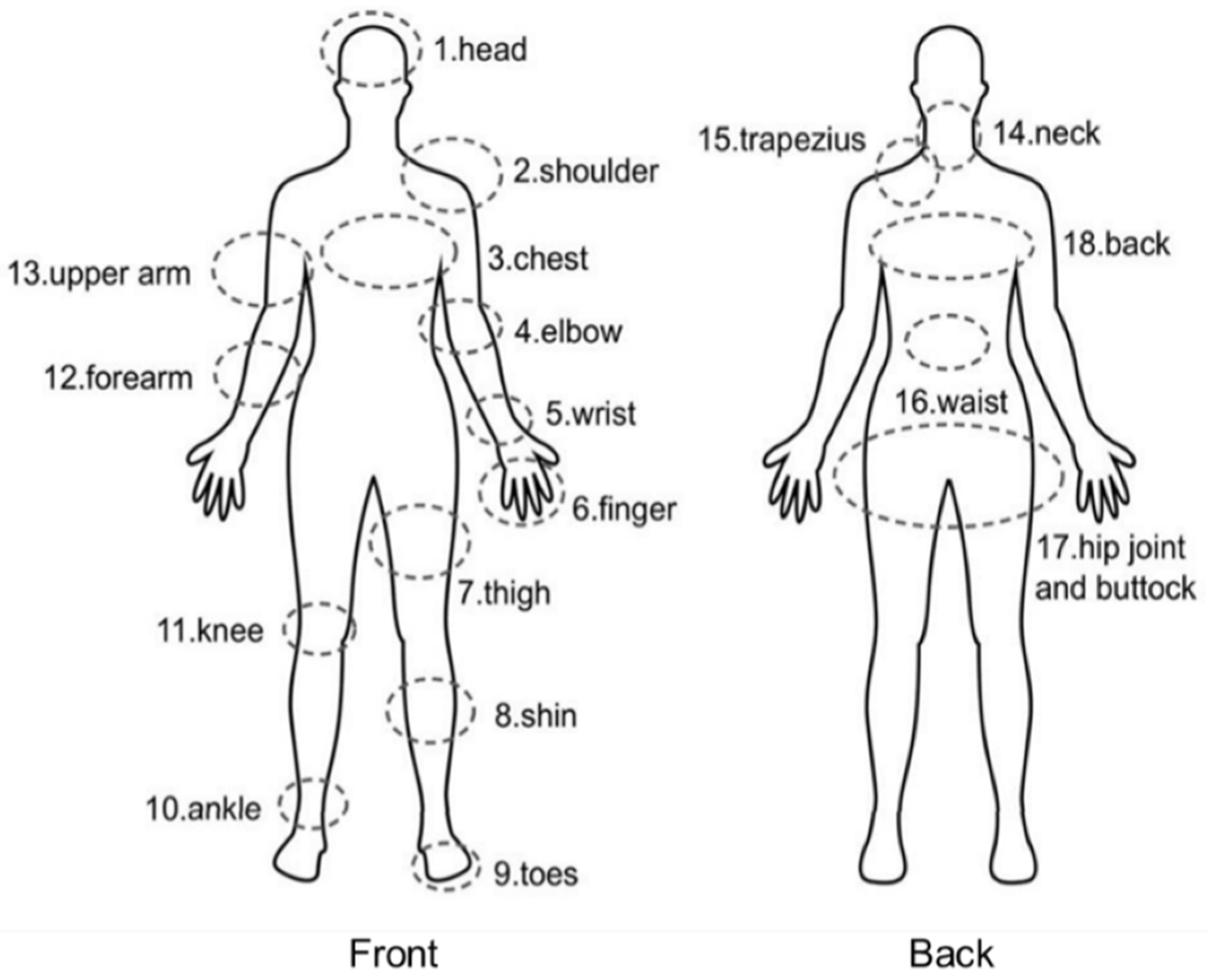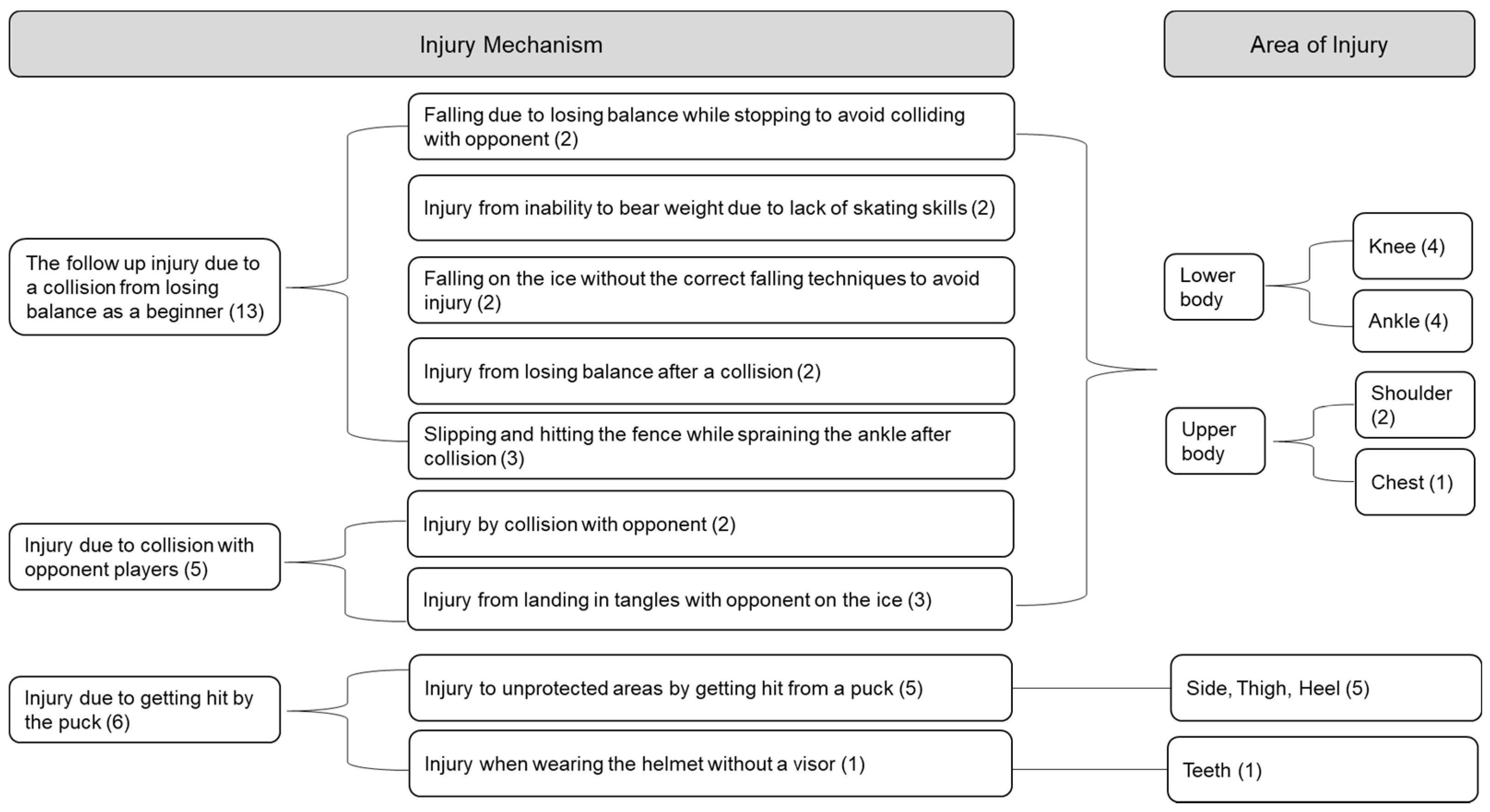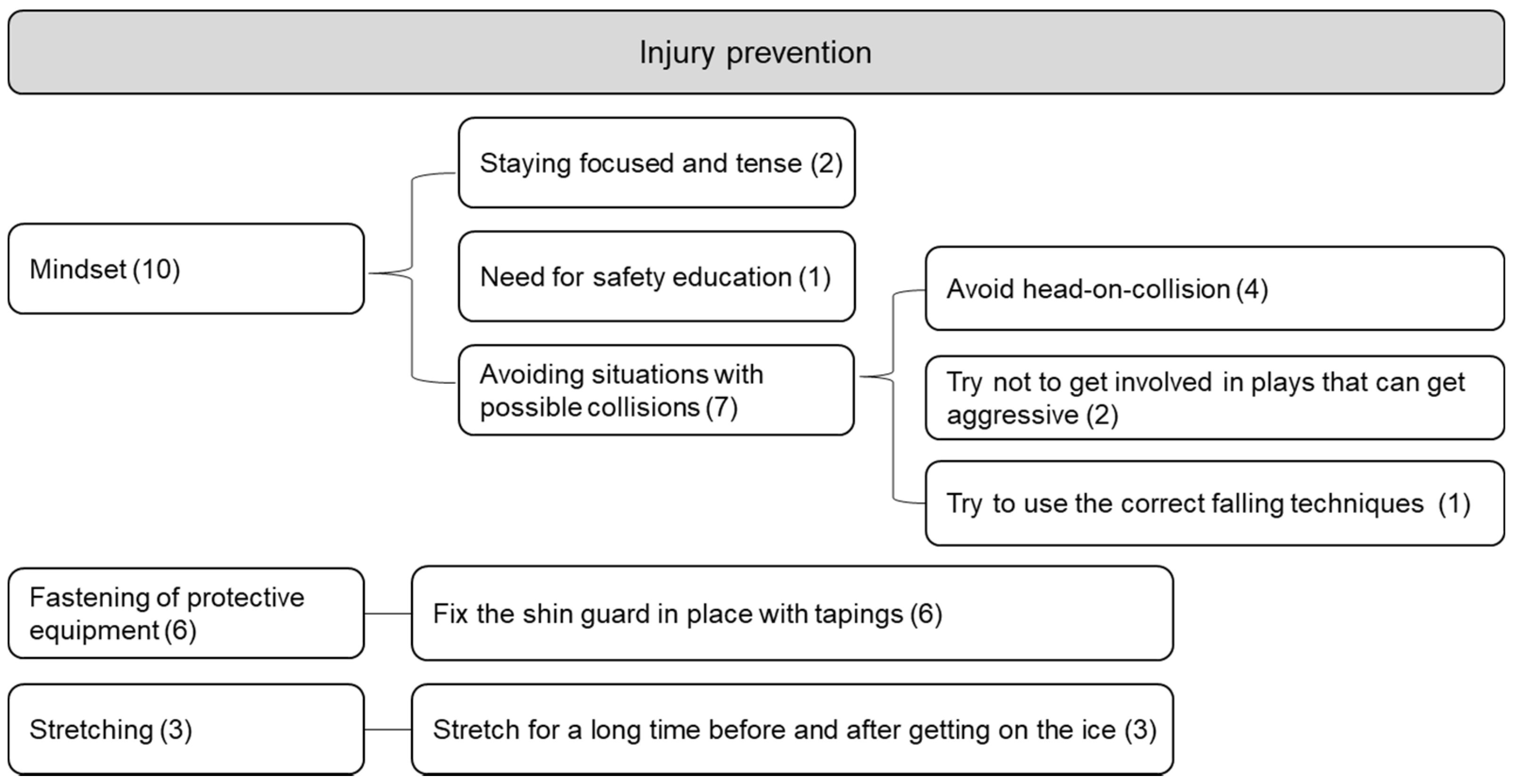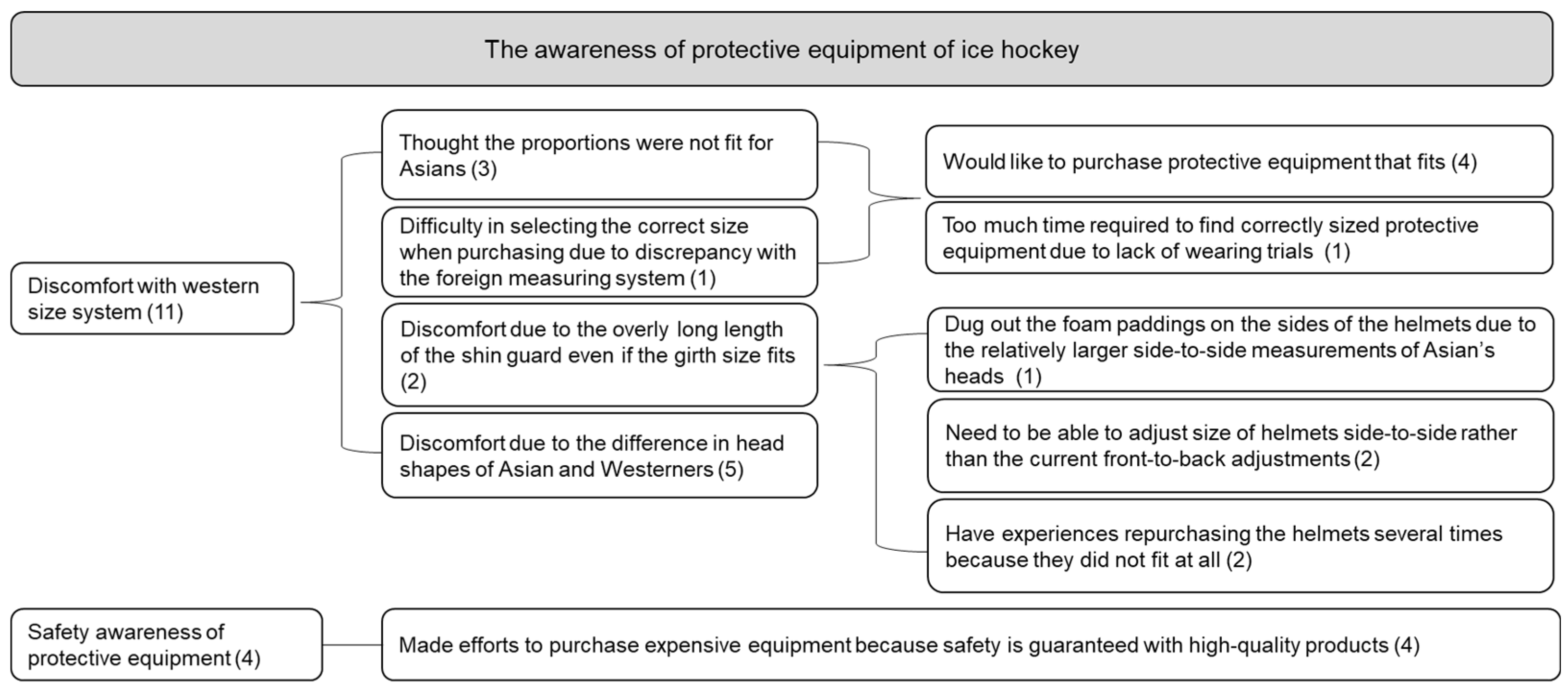Risk Factors Based on Analysis of Injury Mechanism and Protective Equipment for Ice Hockey Amateur Players
Abstract
:1. Introduction
2. Method
2.1. Survey for Data Collection
2.2. Data Analysis
2.3. In-Depth Interview
3. Results
3.1. Characteristics of Survey Participants
3.2. Experience of Injury
3.3. Replacement of Protective Equipment
3.4. Response of Open-Ended Questions
3.5. In-Depth Interview
4. Discussion
5. Conclusions
Author Contributions
Funding
Institutional Review Board Statement
Informed Consent Statement
Data Availability Statement
Conflicts of Interest
References
- Biasca, N.; Simmen, H.P.; Bartolozzi, A.R.; Trentz, O. Review of typical ice hockey injuries. Survey of the North American NHL and Hockey Canada versus European leagues. Unfallchirurg 1995, 98, 283–288. [Google Scholar]
- Seoul Newspaper; Ryu, J. Passion on the Puck Equality on the Ice. Available online: https://www.seoul.co.kr/news/newsView.php?id=20191018038001 (accessed on 17 July 2021).
- Dlugosch, S.; Hu, H.; Chan, A.C. Impact protective clothing in sport: Areas of application and level of utilization. Res. J. Text Appar. 2012, 16, 18–28. [Google Scholar] [CrossRef]
- Emery, C.A.; McKay, C.D.; Campbell, T.S.; Peters, A.N. Examining attitudes toward body checking, levels of emotional empathy, and levels of aggression in body checking and non-body checking youth hockey leagues. Clin. J. Sport Med. 2009, 19, 207–215. [Google Scholar] [CrossRef]
- Asplund, C.; Bettcher, S.; Borchers, J. Facial protection and head injuries in ice hockey: A systematic review. Br. J. Sports Med. 2009, 43, 993–999. [Google Scholar] [CrossRef]
- Biasca, N.; Wirth, S.; Tegner, Y. Head injuries and facial injuries in ice hockey. Eur. J. Trauma Emerg. Surg. 2005, 31, 369–374. [Google Scholar] [CrossRef]
- Crowley, P.J.; Crowley, M.J. Dramatic impact of using protective equipment on the level of hurling-related head injuries: An ultimately successful 27-year programme. Br. J. Sports Med. 2014, 48, 147–150. [Google Scholar] [CrossRef] [PubMed] [Green Version]
- Rampton, J.; Leach, T.; Therrien, S.A.; Bota, G.W.; Rowe, B.H. Head, neck, and facial injuries in ice hockey: The effect of protective equipment. Clin. J. Sport Med. 1997, 7, 162–167. [Google Scholar] [CrossRef] [PubMed] [Green Version]
- Cusimano, M.D.; Sharma, B.; Lawrence, D.W.; Ilie, G.; Silverberg, S.; Jones, R. Trends in North American newspaper reporting of brain injury in ice hockey. PLoS ONE 2013, 8, e61865. [Google Scholar] [CrossRef]
- Pashby, T.; Carson, J.D.; Ordogh, D.; Johnston, K.M.; Tator, C.H.; Mueller, F.O. Eliminate head-checking in ice hockey. Clin. J. Sport Med. 2001, 11, 211–213. [Google Scholar] [CrossRef] [PubMed]
- Kolstad, A.T.; Eliason, P.H.; Galarneau, J.M.; Black, A.M.; Hagel, B.E.; Emery, C.A. 431 Protective Equipment in Youth Ice Hockey: Are Mouthguards and Helmet Age Relevant in Evaluating Concussion Risk? Poster Present. 2021, 55, A164–A165. [Google Scholar]
- Hutchison, M.G.; Comper, P.; Meeuwisse, W.H.; Echemendia, R.J. A systematic video analysis of National Hockey League (NHL) concussions, part I: Who, when, where and what? Br. J. Sports Med. 2015, 49, 547–551. [Google Scholar] [CrossRef] [PubMed]
- Listola, J.; Ruismäki, H.; Valtonen, J.; Welling, J.; Hakkarainen, H. Overuse injuries of Finnish elite junior ice hockey players. Prospective online survey. Eur. J. Soc. Behav. Sci. 2013, 7, 641–655. [Google Scholar] [CrossRef]
- Black, S.; Black, K.; Dhawan, A.; Onks, C.; Seidenberg, P.; Silvis, M. Pediatric sports specialization in elite ice hockey players. Sports Health 2019, 11, 64–68. [Google Scholar] [CrossRef] [PubMed]
- Lee, Y.Y.; Lee, C.H.; Lee, S.M.; Kim, T.G. Etiologic factors of ice hockey injuries in Korean high school players. Pain Phys. 2014, 17, E747–E754. [Google Scholar] [CrossRef]
- Emery, C.A.; Meeuwisse, W.H. Injury rates, risk factors, and mechanisms of injury in minor hockey. Am. J. Sports Med. 2006, 34, 1960–1969. [Google Scholar] [CrossRef] [PubMed]
- Roberts, W.O.; Brust, J.D.; Leonard, B. Youth ice hockey tournament injuries: Rates and patterns compared to season play. Med. Sci. Sports Exerc. 1999, 31, 46–51. [Google Scholar] [CrossRef] [PubMed]
- Cusimano, M.D.; Nastis, S.; Zuccaro, L. Effectiveness of interventions to reduce aggression and injuries among ice hockey players: A systematic review. Can. Med. Assoc. J. 2013, 185, E57–E69. [Google Scholar] [CrossRef] [PubMed] [Green Version]
- MacCormick, L.; Best, T.M.; Flanigan, D.C. Are there differences in ice hockey injuries between sexes? A systematic review. Orthop. J. Sports Med. 2014, 2, 2325967113518181. [Google Scholar] [CrossRef]
- Brisbine, B.R.; Steele, J.R.; Phillips, E.J.; McGhee, D.E. Use and perception of breast protective equipment by female contact football players. J. Sci. Med. Sport. 2020, 23, 820–825. [Google Scholar] [CrossRef]
- Glasgow, A. The Effects of Men’s Lacrosse Protective Equipment on Thermoregulation and Perceptions during Exercise Heat Stress. Bachelor’s Thesis, University of Arkansas, Fayetteville, AR, USA, 2019. Available online: https://scholarworks.uark.edu/hhpruht/86/ (accessed on 15 February 2022).
- Woods, S.; Sosa, E.M.; Kurowski-Burt, A.; Fleming, M.; Matheny, K.; Richardson, A.; Scott, H.; Perry, B.; Zornes, I. Effects of wearing of metacarpal gloves on hand dexterity, function, and perceived comfort: A pilot study. Appl. Ergon. 2021, 97, 103538. [Google Scholar] [CrossRef]
- Nakayama, H.; Hijikata, H.; Tanaka, K. Evaluation of energy absorption characteristics for a sports protector based on high-speed imaging. In Proceedings of the Abstracts of ATEM: International Conference on Advanced Technology in Experimental Mechanics: Asian Conference on Experimental Mechanics, Niigata, Japan, 7–11 October 2019; The Japan Society of Mechanical Engineers: Niigata, Japan, 2019; p. 1008B1000. [Google Scholar]
- Cummins, N.K.; Spears, I.R. The effect of mouthguard design on stresses in the tooth-bone complex. Med. Sci. Sports Exerc. 2002, 34, 942–947. [Google Scholar] [CrossRef] [PubMed]
- McCrory, P. Do mouthguards prevent concussion? Br. J. Sports Med. 2001, 35, 81–82. [Google Scholar] [CrossRef] [PubMed] [Green Version]
- Wisniewski, J.F.; Guskiewicz, K.; Trope, M.; Sigurdsson, A. Incidence of cerebral concussions associated with type of mouthguard used in college football. Dent. Traumatol. 2004, 20, 143–149. [Google Scholar] [CrossRef]
- Pashby, T. Eye injuries in Canadian amateur hockey. Am. J. Sports Med. 1979, 7, 254–257. [Google Scholar] [CrossRef]
- Bogdan, R.; Biklen, S.K. Qualitative Research for Education; Allyn & Bacon: Boston, MA, USA, 1997. [Google Scholar]
- Strauss, A.; Corbin, J. Basics of Qualitative Research: Techniques and Procedures for Developing Grounded Theory; SAGE Publication Inc.: London, UK, 1998; p. 312. ISBN 0-8039-5940-0. [Google Scholar]
- Taeymans, J.; Blaser, V.; Kneubuehl, M.; Rogan, S. Injuries in Ice Hockey: A Questionnaire Survey in Second League Amateur Ice Hockey Players in the Canton of Bern (Switzerland). Sportverletz. Sportschaden Organ Ges. Orthop.-Traumatol. Sportmed. 2019, 33, 216–223. [Google Scholar]
- Åman, M.; Forssblad, M.; Larsén, K. National injury prevention measures in team sports should focus on knee, head, and severe upper limb injuries. Knee Surgery Sports Traumatol. Arthrosc. 2019, 27, 1000–1008. [Google Scholar] [CrossRef] [Green Version]
- Donaldson, L.; Asbridge, M.; Cusimano, M.D. Bodychecking rules and concussion in elite hockey. PLoS ONE 2013, 8, e69122. [Google Scholar] [CrossRef] [PubMed]
- Kuzuhara, K.; Shimamoto, H.; Mase, Y. Ice hockey injuries in a Japanese elite team: A 3-year prospective study. J. Athl. Train. 2009, 44, 208–214. [Google Scholar] [CrossRef]
- Roberts, W.O.; Brust, J.D.; Leonard, B.; Hebert, B.J. Fair-play rules and injury reduction in ice hockey. Arch. Pediatr. Adolesc. Med. 1996, 150, 140–145. [Google Scholar] [CrossRef]
- Buergi, F.; Derrer, P.; Niemann, S.; Bruegger, O. 036 Barriers to wrist protector use in Swiss snowboarders. Br. J. Sports Med. 2020, 54 (Suppl. S1), A16. [Google Scholar]
- Boorady, L.M. Impact protection equipment for female ice hockey players. Res. J. Text Apparel. 2006, 10, 67–72. [Google Scholar] [CrossRef]




| Sex | Years Played | Age Group | Number of Times Played Per Week | |
|---|---|---|---|---|
| P1 | Male | 5 years | 40s | 3 times |
| P2 | Male | 4 years | 40s | 2 times |
| P3 | Male | 10 years | 40s | 3 times |
| P4 | Female | 10 years | 30s | 1 time |
| P5 | Male | 15 years | 40s | 5 times |
| Category | N | (%) | |
|---|---|---|---|
| Sex | Male | 80 | (78.4) |
| Female | 22 | (21.6) | |
| Occupation | College students | 11 | (10.8) |
| Working in professional field | 25 | (24.5) | |
| Administration | 6 | (5.9) | |
| Office worker | 23 | (22.6) | |
| Self-employed | 17 | (16.7) | |
| Others | 20 | (19.6) | |
| Age group | 20s | 15 | (14.7) |
| 30s | 24 | (23.5) | |
| 40s | 55 | (53.9) | |
| 50s | 6 | (5.9) | |
| 60s | 2 | (1.9) | |
| years played | Less than 1 year | 13 | (12.8) |
| 1–5 years | 35 | (34.2) | |
| 5–10 years | 18 | (17.7) | |
| More than 10 years | 36 | (35.3) | |
| number of times played per month | Less than 4 times | 51 | (50.0) |
| 5–9 times | 33 | (32.4) | |
| More than 10 times | 18 | (17.6) | |
| Category | N | (%) | |
|---|---|---|---|
| Experience of injury | Yes | 60 | (58.8) |
| No | 42 | (41.2) | |
| Area of injury | Knee | 23 | (22.6) |
| Shoulder | 22 | (21.6) | |
| Ankle | 21 | (20.6) | |
| Wrist | 15 | (14.7) | |
| Waist | 9 | (8.8) | |
| Chest | 8 | (7.8) | |
| Fingers | 8 | (7.8) | |
| Others (thigh, neck, hip joint, head, etc.) | 23 | (17.8) | |
| Total | 129 | (126.5) | |
| Type of injury | Fracture | 18 | (17.7) |
| Contusion | 32 | (31.4) | |
| Sprain | 34 | (33.3) | |
| Abrasion | 11 | (10.8) | |
| Concussion | 1 | (0.9) | |
| Others | 9 | (8.9) | |
| Total | 105 | (102.9) | |
| Experienced Injury | Have No Experience of Injury | χ2 | p | ||||
|---|---|---|---|---|---|---|---|
| N | (%) | N | (%) | ||||
| Year played | Less than 5 years | 20 | (39.6) | 29 | (60.4) | 11.212 | 0.001 |
| More than 5 years | 39 | (75.5) | 14 | (26.4) | |||
| Sex | Male | 53 | (65.0) | 27 | (33.8) | 59.941 | 0.000 |
| Female | 7 | (31.8) | 15 | (68.2) | |||
| Protective Function | Price | Weight | Size | Brand | Design | ||
| Priority factors to consider for replacement | First | 48 | 19 | 5 | 12 | 8 | 10 |
| Second | 31 | 30 | 16 | 12 | 5 | 8 | |
| Third | 14 | 31 | 13 | 16 | 12 | 16 | |
| Total order score a | 347 | 216 | 86 | 112 | 67 | 90 | |
| Rankings | 1 | 2 | 5 | 3 | 6 | 4 | |
| Jock Pants | Shin Guard | Elbow Pad | Shoulder Pad | Pants | Neck Guard | ||
| Principal equipment chosen for replacement when considering protection | First | 21 | 31 | 6 | 18 | 23 | 3 |
| Second | 5 | 37 | 17 | 21 | 17 | 5 | |
| Third | 7 | 13 | 30 | 17 | 33 | 2 | |
| Total order score a | 127 | 279 | 111 | 170 | 199 | 32 | |
| Rankings | 4 | 1 | 5 | 3 | 2 | 6 |
| Category (n, %) | Subtopics | Frequency (n, %) |
|---|---|---|
| Size (n = 10, 26.3%) | Discomfort due to the different size system especially if worn without testing it on | (n = 9, 23.6%) |
| For women, finding the right fitted size | (n = 1, 2.6%) | |
| Management (n = 3, 7.8%) | Dissatisfaction due to inability of washing/cleaning equipment | (n = 3, 7.9%) |
| Wearing (n = 13, 34.2%) | Discomfort due to heavy weight | (n = 8, 21.0%) |
| Discomfort from elbow pad or shin guards slipping | (n = 5, 13.1%) | |
| Equipment of protective level and price (n = 12, 31.6%) | Increased protective ability of equipment means increased price. | (n = 6, 15.8%) |
| Higher protective ability means more safe and comfortable | (n = 4, 10.5%) | |
| More expensive equipment is more comfortable | (n = 2, 5.2%) |
Publisher’s Note: MDPI stays neutral with regard to jurisdictional claims in published maps and institutional affiliations. |
© 2022 by the authors. Licensee MDPI, Basel, Switzerland. This article is an open access article distributed under the terms and conditions of the Creative Commons Attribution (CC BY) license (https://creativecommons.org/licenses/by/4.0/).
Share and Cite
Jin, H.; Lee, H. Risk Factors Based on Analysis of Injury Mechanism and Protective Equipment for Ice Hockey Amateur Players. Int. J. Environ. Res. Public Health 2022, 19, 4232. https://doi.org/10.3390/ijerph19074232
Jin H, Lee H. Risk Factors Based on Analysis of Injury Mechanism and Protective Equipment for Ice Hockey Amateur Players. International Journal of Environmental Research and Public Health. 2022; 19(7):4232. https://doi.org/10.3390/ijerph19074232
Chicago/Turabian StyleJin, Heejae, and Hyojeong Lee. 2022. "Risk Factors Based on Analysis of Injury Mechanism and Protective Equipment for Ice Hockey Amateur Players" International Journal of Environmental Research and Public Health 19, no. 7: 4232. https://doi.org/10.3390/ijerph19074232
APA StyleJin, H., & Lee, H. (2022). Risk Factors Based on Analysis of Injury Mechanism and Protective Equipment for Ice Hockey Amateur Players. International Journal of Environmental Research and Public Health, 19(7), 4232. https://doi.org/10.3390/ijerph19074232







